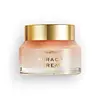What's inside
What's inside
 Key Ingredients
Key Ingredients

 Benefits
Benefits

 Concerns
Concerns

 Ingredients Side-by-side
Ingredients Side-by-side

Water
Skin ConditioningVitis Vinifera Seed Oil
EmollientGlycerin
HumectantPhenyl Trimethicone
Skin ConditioningButylene Glycol
HumectantIsopropyl Isostearate
EmollientTheobroma Cacao Seed Butter
EmollientHydrogenated Ethylhexyl Olivate
EmollientCaprylic/Capric Triglyceride
MaskingDimethicone
EmollientCamelina Sativa Seed Oil
Skin ConditioningStearyl Alcohol
EmollientGlyceryl Stearate Se
EmulsifyingButyrospermum Parkii Butter
Skin ConditioningAmmonium Acryloyldimethyltaurate/Vp Copolymer
Simmondsia Chinensis Seed Oil
EmollientNiacinamide
SmoothingStearic Acid
CleansingBenzyl Alcohol
PerfumingCetyl Alcohol
EmollientParfum
MaskingHydrogenated Olive Oil Unsaponifiables
EmollientStevia Rebaudiana Extract
Polyacrylamide
C13-14 Isoparaffin
EmollientDisodium EDTA
Sodium Ascorbyl Phosphate
AntioxidantTitanium Dioxide
Cosmetic ColorantAllantoin
Skin ConditioningDehydroacetic Acid
PreservativeLaureth-7
EmulsifyingSodium Hyaluronate
HumectantPotassium Sorbate
PreservativeHexyl Cinnamal
PerfumingBenzyl Salicylate
PerfumingCaprylyl Glycol
EmollientSorbic Acid
PreservativeBenzyl Benzoate
AntimicrobialBis(Tripeptide-1) Copper Acetate
Skin ConditioningEthylhexylglycerin
Skin ConditioningWater, Vitis Vinifera Seed Oil, Glycerin, Phenyl Trimethicone, Butylene Glycol, Isopropyl Isostearate, Theobroma Cacao Seed Butter, Hydrogenated Ethylhexyl Olivate, Caprylic/Capric Triglyceride, Dimethicone, Camelina Sativa Seed Oil, Stearyl Alcohol, Glyceryl Stearate Se, Butyrospermum Parkii Butter, Ammonium Acryloyldimethyltaurate/Vp Copolymer, Simmondsia Chinensis Seed Oil, Niacinamide, Stearic Acid, Benzyl Alcohol, Cetyl Alcohol, Parfum, Hydrogenated Olive Oil Unsaponifiables, Stevia Rebaudiana Extract, Polyacrylamide, C13-14 Isoparaffin, Disodium EDTA, Sodium Ascorbyl Phosphate, Titanium Dioxide, Allantoin, Dehydroacetic Acid, Laureth-7, Sodium Hyaluronate, Potassium Sorbate, Hexyl Cinnamal, Benzyl Salicylate, Caprylyl Glycol, Sorbic Acid, Benzyl Benzoate, Bis(Tripeptide-1) Copper Acetate, Ethylhexylglycerin
Water
Skin ConditioningGlycerin
HumectantDimethicone
EmollientCetearyl Olivate
Sorbitan Olivate
EmulsifyingSodium Hyaluronate
HumectantSerine
MaskingGlycine
BufferingAlanine
MaskingThreonine
Arginine
MaskingProline
Skin ConditioningLysine Hcl
Skin ConditioningGlutamic Acid
HumectantSodium PCA
HumectantPCA
HumectantSodium Lactate
BufferingUrea
BufferingSodium Chloride
MaskingCitric Acid
BufferingBetaine
HumectantAllantoin
Skin ConditioningFructose
HumectantMaltose
MaskingTrehalose
HumectantGlucose
HumectantPentylene Glycol
Skin ConditioningSynthetic Beeswax
Emulsion StabilisingPolyacrylate Crosspolymer-6
Emulsion StabilisingDimethicone Crosspolymer
Emulsion StabilisingDimethiconol
EmollientEthylhexylglycerin
Skin ConditioningCaprylyl Glycol
EmollientSodium Hydroxide
BufferingWater, Glycerin, Dimethicone, Cetearyl Olivate, Sorbitan Olivate, Sodium Hyaluronate, Serine, Glycine, Alanine, Threonine, Arginine, Proline, Lysine Hcl, Glutamic Acid, Sodium PCA, PCA, Sodium Lactate, Urea, Sodium Chloride, Citric Acid, Betaine, Allantoin, Fructose, Maltose, Trehalose, Glucose, Pentylene Glycol, Synthetic Beeswax, Polyacrylate Crosspolymer-6, Dimethicone Crosspolymer, Dimethiconol, Ethylhexylglycerin, Caprylyl Glycol, Sodium Hydroxide
 Reviews
Reviews

Ingredients Explained
These ingredients are found in both products.
Ingredients higher up in an ingredient list are typically present in a larger amount.
Allantoin is a soothing ingredient known for its protective and moisturizingg properties. Because of this, it is often added to products with strong active ingredients.
Studies show higher concentrations of this ingredient can promote wound healing.
Though it can be derived from the comfrey plant, allantoin is produced synthetically for cosmetic products to ensure purity.
Learn more about AllantoinCaprylyl Glycol is a humectant and emollient, meaning it attracts and preserves moisture.
It is a common ingredient in many products, especially those designed to hydrate skin. The primary benefits are retaining moisture, skin softening, and promoting a healthy skin barrier.
Though Caprylyl Glycol is an alcohol derived from fatty acids, it is not the kind that can dry out skin.
This ingredient is also used as a preservative to extend the life of products. It has slight antimicrobial properties.
Learn more about Caprylyl GlycolDimethicone is a type of synthetic silicone created from natural materials such as quartz.
What it does:
Dimethicone comes in different viscosities:
Depending on the viscosity, dimethicone has different properties.
Ingredients lists don't always show which type is used, so we recommend reaching out to the brand if you have questions about the viscosity.
This ingredient is unlikely to cause irritation because it does not get absorbed into skin. However, people with silicone allergies should be careful about using this ingredient.
Note: Dimethicone may contribute to pilling. This is because it is not oil or water soluble, so pilling may occur when layered with products. When mixed with heavy oils in a formula, the outcome is also quite greasy.
Learn more about DimethiconeEthylhexylglycerin (we can't pronounce this either) is commonly used as a preservative and skin softener. It is derived from glyceryl.
You might see Ethylhexylglycerin often paired with other preservatives such as phenoxyethanol. Ethylhexylglycerin has been found to increase the effectiveness of these other preservatives.
Glycerin is already naturally found in your skin. It helps moisturize and protect your skin.
A study from 2016 found glycerin to be more effective as a humectant than AHAs and hyaluronic acid.
As a humectant, it helps the skin stay hydrated by pulling moisture to your skin. The low molecular weight of glycerin allows it to pull moisture into the deeper layers of your skin.
Hydrated skin improves your skin barrier; Your skin barrier helps protect against irritants and bacteria.
Glycerin has also been found to have antimicrobial and antiviral properties. Due to these properties, glycerin is often used in wound and burn treatments.
In cosmetics, glycerin is usually derived from plants such as soybean or palm. However, it can also be sourced from animals, such as tallow or animal fat.
This ingredient is organic, colorless, odorless, and non-toxic.
Glycerin is the name for this ingredient in American English. British English uses Glycerol/Glycerine.
Learn more about GlycerinSodium Hyaluronate is hyaluronic acid's salt form. It is commonly derived from the sodium salt of hyaluronic acid.
Like hyaluronic acid, it is great at holding water and acts as a humectant. This makes it a great skin hydrating ingredient.
Sodium Hyaluronate is naturally occurring in our bodies and is mostly found in eye fluid and joints.
These are some other common types of Hyaluronic Acid:
Learn more about Sodium HyaluronateWater. It's the most common cosmetic ingredient of all. You'll usually see it at the top of ingredient lists, meaning that it makes up the largest part of the product.
So why is it so popular? Water most often acts as a solvent - this means that it helps dissolve other ingredients into the formulation.
You'll also recognize water as that liquid we all need to stay alive. If you see this, drink a glass of water. Stay hydrated!
Learn more about Water